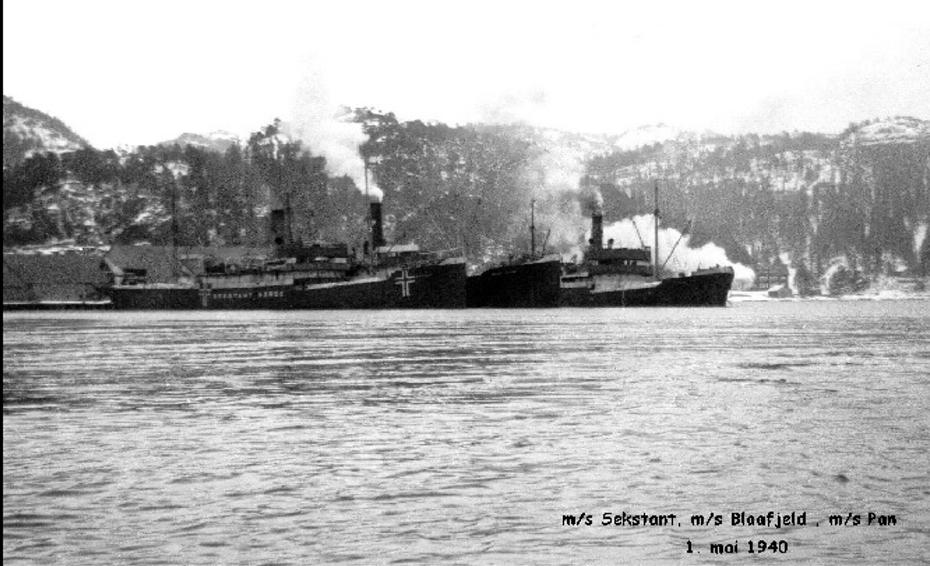
|
Sekstant, Blaafield og Pan ved kai på Salsbruket. Bildet er tatt 1. Mai 1940 |
|
Sekstant Built in Bergen 1920. Previous name: Nordstrand until 1922. Bombed by German aircraft at Kolvereid, north of Namsos on May 4-1940, all survived. Lauritz Pettersen in "Hjemmeflåten - mellom venn og fiende" (The Home Fleet - Between Friend and Enemy, 1992) says that the 3 ships Pan, Blaafjeld I and Sekstant were near Salsbruket in Oppløygsfjord (Rørvik) loading wood pulp for England in Apr.-1940. Pan was done at the end of Apr. but was ordered to wait for the others so that they could leave in the same convoy, probably in connection with the allied evacuation of Namsos. Because of this there were quite a few English warships in the area. Sekstant and Blaafjeld I were finished loading the cargo on May 1, and moved into the fjord while awaiting sailing orders, Pan was in Sildvik and Blaafjeld I and Sekstant in Urshalsvåg, closely watched by German aircraft. On May 4 they attacked and Blaafjeld I and Sekstant became a total loss, while the wreck of Pan remained for 2 years, before she was raised and repaired. |
|
http://www.warsailors.com/freefleet/norfleets2.html#sekstant |
|
Blaafjeld I Built Trondheim 1918. Built at Trondhjem mek. Verksted, Trondheim, 226.3' x 36.5' x 15.7' (according to this posting to my Ship Forum, which adds she had previously had the name Annemor). WW II: Blaafjeld I, in ballast for Tyne, is listed as sailing in Convoy HN 16 from Norway to the U.K. in March.-1940 - follow link for more info, several Norwegian ships took part. According to Lauritz Pettersen's "Hjemmeflåten - mellom venn og fiende" (The Home Fleet - Between Friend and Enemy, 1992) this ship, along with Pan and Sekstant were near Salsbruket in Oppløygsfjord (Rørvik) loading wood pulp for England during the early days of war in Norway. Pan was done at the end of Apr. but was ordered to wait for the others so that they could leave in the same convoy, probably in connection with the allied evacuation of Namsos. Because of this there were quite a few English warships in the area. Sekstant and Blaafjeld I had finished loading the cargo on May 1, and moved into the fjord to await sailing orders; Pan was in Sildvik and Blaafjeld I and Sekstant in Urshalsvåg (near Kolvereid), closely watched by German aircraft. On May 4-1940 they attacked and Blaafjeld I and Sekstant became a total loss, while the wreck of Pan remained for 2 years, before she was raised and repaired. No casualties. Blaafjeld I's intended destination was Rochester. Related external links: |
|
WW II: Pan, cargo of pulp for Grimsby, is listed as sailing in Convoy HN 15 from Norway to the U.K. in Febr.-1940 - follow link for more info, several Norwegian ships took part. Bombed by German aircraft in Sildvikfjord on May 4-1940 and damaged, having been hit between hatch No. 3 and 4. (This ship ended up in Nortraship's register, even though she did not get out of Norway). Lauritz Pettersen in "Hjemmeflåten - mellom venn og fiende" (The Home Fleet - Between Friend and Enemy, 1992) says that the 3 ships Pan, Blaafjeld I and Sekstant were near Salsbruket in Oppløygsfjord (Rørvik) loading wood pulp for England in Apr.-1940. Pan was done at the end of Apr. but was ordered to wait for the others so that they could leave in the same convoy, probably in connection with the allied evacuation of Namsos. Because of this there were quite a few English warships in the area. Sekstant and Blaafjeld I were finished loading the cargo on May 1, and moved into the fjord while awaiting sailing orders, Pan was in Sildvik and Blaafjeld I and Sekstant in Urshalsvåg, closely watched by German aircraft. On May 4 they attacked and Blaafjeld I and Sekstant became a total loss. The wreck of Pan remained for 2 years, before she was raised and repaired. |
|
Foto: Einar Iversen © Svein Iversen |